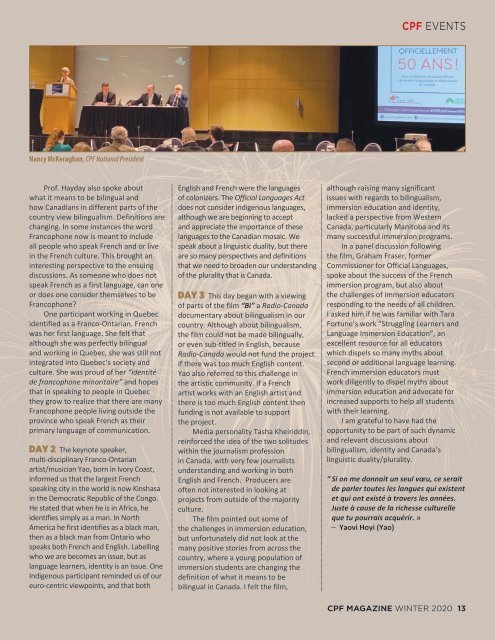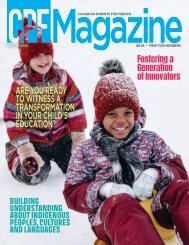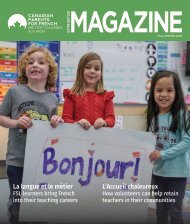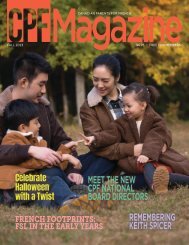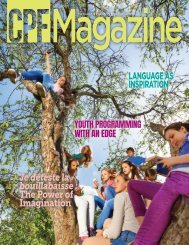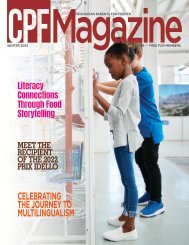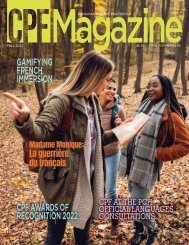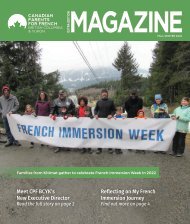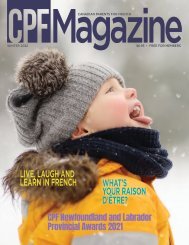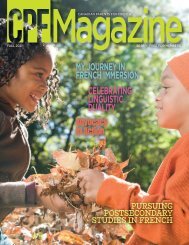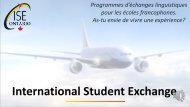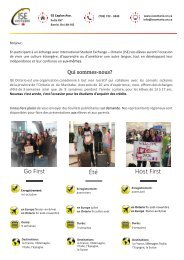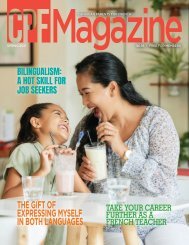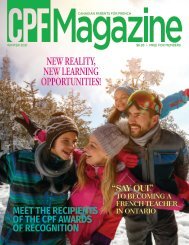CPF Magazine Winter 2020 Issue
A national network of volunteers, parents and stakeholders who value French as an integral part of Canada. CPF Magazine is dedicated to the promotion and creation of French-second-language learning opportunities for young Canadians.
A national network of volunteers, parents and stakeholders who value French as an integral part of Canada. CPF Magazine is dedicated to the promotion and creation of French-second-language learning opportunities for young Canadians.
You also want an ePaper? Increase the reach of your titles
YUMPU automatically turns print PDFs into web optimized ePapers that Google loves.
<strong>CPF</strong> EVENTS<br />
Nancy McKeraghan, <strong>CPF</strong> National President<br />
Prof. Hayday also spoke about<br />
what it means to be bilingual and<br />
how Canadians in different parts of the<br />
country view bilingualism. Definitions are<br />
changing. In some instances the word<br />
Francophone now is meant to include<br />
all people who speak French and or live<br />
in the French culture. This brought an<br />
interesting perspective to the ensuing<br />
discussions. As someone who does not<br />
speak French as a first language, can one<br />
or does one consider themselves to be<br />
Francophone?<br />
One participant working in Quebec<br />
identified as a Franco-Ontarian. French<br />
was her first language. She felt that<br />
although she was perfectly bilingual<br />
and working in Quebec, she was still not<br />
integrated into Quebec’s society and<br />
culture. She was proud of her “identité<br />
de francophone minoritaire” and hopes<br />
that in speaking to people in Quebec<br />
they grow to realize that there are many<br />
Francophone people living outside the<br />
province who speak French as their<br />
primary language of communication.<br />
DAY 2 The keynote speaker,<br />
multi-disciplinary Franco-Ontarian<br />
artist/musician Yao, born in Ivory Coast,<br />
informed us that the largest French<br />
speaking city in the world is now Kinshasa<br />
in the Democratic Republic of the Congo.<br />
He stated that when he is in Africa, he<br />
identifies simply as a man. In North<br />
America he first identifies as a black man,<br />
then as a black man from Ontario who<br />
speaks both French and English. Labelling<br />
who we are becomes an issue, but as<br />
language learners, identity is an issue. One<br />
Indigenous participant reminded us of our<br />
euro-centric viewpoints, and that both<br />
English and French were the languages<br />
of colonizers. The Official Languages Act<br />
does not consider indigenous languages,<br />
although we are beginning to accept<br />
and appreciate the importance of these<br />
languages to the Canadian mosaic. We<br />
speak about a linguistic duality, but there<br />
are so many perspectives and definitions<br />
that we need to broaden our understanding<br />
of the plurality that is Canada.<br />
DAY 3 This day began with a viewing<br />
of parts of the film “Bi” a Radio-Canada<br />
documentary about bilingualism in our<br />
country. Although about bilingualism,<br />
the film could not be made bilingually,<br />
or even sub-titled in English, because<br />
Radio-Canada would not fund the project<br />
if there was too much English content.<br />
Yao also referred to this challenge in<br />
the artistic community. If a French<br />
artist works with an English artist and<br />
there is too much English content then<br />
funding is not available to support<br />
the project.<br />
Media personality Tasha Kheiriddin,<br />
reinforced the idea of the two solitudes<br />
within the journalism profession<br />
in Canada, with very few journalists<br />
understanding and working in both<br />
English and French. Producers are<br />
often not interested in looking at<br />
projects from outside of the majority<br />
culture.<br />
The film pointed out some of<br />
the challenges in immersion education,<br />
but unfortunately did not look at the<br />
many positive stories from across the<br />
country, where a young population of<br />
immersion students are changing the<br />
definition of what it means to be<br />
bilingual in Canada. I felt the film,<br />
although raising many significant<br />
issues with regards to bilingualism,<br />
immersion education and identity,<br />
lacked a perspective from Western<br />
Canada, particularly Manitoba and its<br />
many successful immersion programs.<br />
In a panel discussion following<br />
the film, Graham Fraser, former<br />
Commissioner for Official Languages,<br />
spoke about the success of the French<br />
immersion program, but also about<br />
the challenges of immersion educators<br />
responding to the needs of all children.<br />
I asked him if he was familiar with Tara<br />
Fortune’s work “Struggling Learners and<br />
Language Immersion Education”, an<br />
excellent resource for all educators<br />
which dispels so many myths about<br />
second or additional language learning.<br />
French immersion educators must<br />
work diligently to dispel myths about<br />
immersion education and advocate for<br />
increased supports to help all students<br />
with their learning.<br />
I am grateful to have had the<br />
opportunity to be part of such dynamic<br />
and relevant discussions about<br />
bilingualism, identity and Canada’s<br />
linguistic duality/plurality.<br />
“ Si on me donnait un seul vœu, ce serait<br />
de parler toutes les langues qui existent<br />
et qui ont existé à travers les années.<br />
Juste à cause de la richesse culturelle<br />
que tu pourrais acquérir. »<br />
– Yaovi Hoyi (Yao)<br />
<strong>CPF</strong> MAGAZINE WINTER <strong>2020</strong> 13


